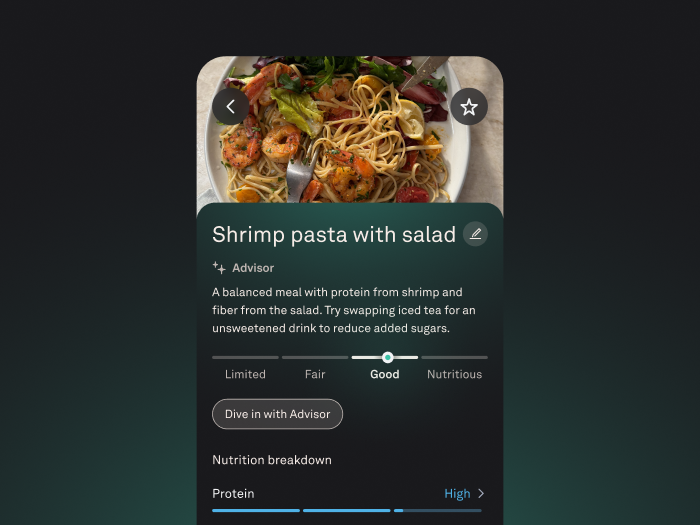What makes a meal “healthy” isn’t one-size-fits-all, and it definitely isn’t about perfection. Nutrition Level, a new update to the Meals feature, helps you identify dietary patterns that contribute to your energy, recovery, and overall well-being. This feature emphasizes understanding these broader patterns rather than fixating on individual food choices or adhering to rigid diet rules.
Whether you’re logging every meal or just checking in when it feels helpful, Nutrition Level offers a simple, real-world view of how your meals are supporting you. Your meal’s nutrition level will be categorized as one of the following:
- Nutritious
- Good
- Fair
- Limited
And rather than overwhelming you with numbers, it focuses on a few key contributors that matter most for feeling good and fueling well:
- Fiber
- Protein
- Added sugar
- Processing level
Read on for a deeper dive on each contributor and an explanation of how Oura analyzes your plate.
Fiber: The Underrated Powerhouse
Fiber may not get the spotlight, but it plays a powerful role in long-term health—and most of us aren’t getting enough. In fact, fewer than 10% of U.S. adults meet their daily fiber recommendations. That’s why Oura includes fiber in your Nutrition Level: to gently encourage more of the foods that promote fullness and support long-term health.
Diets higher in fiber are linked to lower risk of cardiovascular disease and type 2 diabetes. Found in fruits, veggies, legumes, and whole grains, fiber is a core component of a healthy diet. Importantly, higher fiber intake has also been consistently linked to better blood sugar regulation, and improved gut health.
Protein: Fuel for Strength and Satiety
Protein isn’t just for gym days. It plays a key role in maintaining muscle, supporting recovery, and helping you stay full between meals. Whether it’s from eggs, beans, tofu, or fish, including a source of protein in your meals can help steady your energy and your appetite.
Your Nutrition Level reflects when meals include a good source of protein—and for good reason. Protein is known to be the most satiating macronutrient. Research shows that increasing protein from 15% to 30% of caloric intake can naturally reduce calorie consumption and improve satiety.
That doesn’t mean eating huge amounts. Just enough to support your body’s everyday needs makes a difference.
Added Sugar: Keeping It in Check
Let’s be clear: Sugar isn’t “bad,” and there’s no need to eliminate sweet treats. But when sugar is added during processing—think syrups, sweetened drinks, and packaged desserts—it can add up quickly and crowd out more nutrient-rich foods.
Too much added sugar has been linked to blood sugar swings and potential energy dips, as well as long-term health risks. One large study found that individuals consuming more than 25% of their calories from added sugar had nearly triple the risk of cardiovascular mortality compared to those consuming less than 10%.
That’s why your level encourages meals that keep added sugar in a reasonable range. The goal isn’t to shame sweets, but to support balance.
Processing Level: Whole Foods, More Often
Processing doesn’t automatically mean unhealthy. Cooking, freezing, or blending are all forms of processing. What we’re really talking about is ultra-processed foods — products high in additives, refined starches, and added sugars that are engineered to be hard to stop eating.
There’s growing evidence that ultra-processed meals can disrupt appetite signals and lead to overeating, even when calories and nutrients are matched. In one study, participants consuming an ultra-processed diet ate around 500 more calories per day than when eating a minimally processed diet and gained weight as a result. These findings support growing concerns that the structure and formulation of ultra-processed foods, not just their nutrient content, may drive overconsumption and poor metabolic health outcomes.
Meals made mostly from whole or minimally processed ingredients, like vegetables, grains, or simply prepared proteins, tend to be more filling and nutrient-dense. The level rewards meals that lean in that direction, helping you tune into the kind of food that supports sustained energy and better recovery.
READ MORE: The Essential Guide to Eating for Metabolic Health
Designed for Real Life
Not every meal will be perfectly balanced, and that’s not the goal. Oura gives you feedback right after you log a meal so you can see how that single choice supports your energy and recovery. Each entry then rolls into a daily Nutrition Level, making larger patterns easier to spot.
Here’s the quick logic behind every meal’s level:
Fiber or protein add points.
- High amounts of one nutrient lifts the level; plenty of both lifts it even more.
- A fiber-rich apple or a protein-packed egg both earn credit. Most whole foods naturally excel in one area, not both, so a single meal doesn’t need to tick every box to do well. We want to reward smart choices that fit real life, rather than chasing a perfect-on-paper plate every time.
Added sugar and ultra-processing subtract points.
- The higher the added sugar or processing level of the meal, the bigger the drop in level.
- The more added sugar or processing a meal contains, the steeper the drop. We weigh these factors more heavily for the Nutrition Level because the further a food drifts from its whole-food form, the less it tends to satisfy and nourish.
For example:
High-scoring meal: Overnight oats with plain Greek yogurt, blueberries, and almond butter
- Plenty of natural fiber from the oats and berries, solid protein from the yogurt and almond butter, no added sugar, and nothing ultra-processed give this meal a big lift.
Low-scoring meal: A frosted pastry with a vanilla latte
- Minimal fiber or protein and lots of added sugar from highly processed ingredients makes for a low level. Comparing this to the high level meal you can imagine how this is more likely to have you feeling sluggish.
So whether you’re logging a colorful lunch or a quick granola bar between meetings, it’s worth snapping that photo. Your Nutrition Level isn’t judging you; it’s helping you understand your meals better and make informed shifts over time.
And you don’t have to log everything to benefit. Some people use it as a consistent habit. Others check in a few times a week to get a sense of how different meals or snacks affect their level, and most importantly: how that relates to how they feel. However you use it, Nutrition Level can help support better choices—without the pressure to be perfect.
Because nutrition isn’t about rules. It’s about learning what fuels you best.
RELATED: Why Strength Training Is a Game-Changer for Metabolic Health (And How to Get Started)
About the Author
Renee Wurth, PhD, RD, is the metabolic health scientific advisor at Oura. She brings 15 years of experience as a registered dietitian and completed her PhD in population health at Northeastern University, with fellowships at MIT and UC Berkeley, and a postdoctoral fellowship at the Harvard T.H. Chan School of Public Health. Her research has focused on the intersection of environmental, social, and nutritional health. Renee has led research in tech for over 7 years, including heading quantitative research at Daily Harvest. She continues to support academic research as a research affiliate at both UPenn and UC Berkeley, and is passionate about making nutrition more accessible to everyone.












